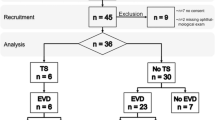Abstract
Background
Vitreous hemorrhage (Terson’s syndrome) and other intraocular hemorrhages have been reported in up to 40% of patients with subarachnoidal hemorrhage (SAH). Our objective was to determine prospectively the frequency of intraocular involvement and its relationship to the grade of SAH.
Methods
Seventy-four consecutive patients with SAH were prospectively examined. The patients were classified according to Hunt and Hess and ophthalmological examination was performed by an ophthalmologist.
Results
In all patients SAH was caused by a ruptured cerebral aneurysm. Intraocular hemorrhages were present in 28% of the patients, all of whom had retinal hemorrhages, which were detectable unilaterally in 45%, while 15% of these patients exhibited typical retrohyaloidal or vitreal hemorrhages. Ocular involvement was statistically more frequent in patients with a higher grade of SAH according to Hunt and Hess.
Conclusions
Due to ocular involvement in more than a quarter of the patients with SAH and due to the fact that ocular involvement is related to the severity of SAH, screening of patients with SAH is recommended, especially when no reliable data about visual function are available. Early vitrectomy of vitreous hemorrhages provides a more effective rehabilitation.




Similar content being viewed by others
References
Anderson DR (1970) Ultrastructure of the optic nerve head. Arch Ophthalmol 83:63–73
Doubler F, Marlow SB (1917) A case of hemorrhage into the optic nerve head sheath as a direct extension from a diffuse intra-meningeal hemorrhage caused by rupture of an aneurysm of a cerebral artery. Arch Ophthalmol 46:533–536
Fahmy JA (1973) Fundal hemorrhage in ruptured intracranial aneurysm: I—Material, frequency and morphology. Acta Ophthalmol 51:289–298
Fisher CM, Kistler JP, Davis JM (1980) Relation of cerebral vasospasm to subarachnoid hemorrhage visualized by CT scanning. Neurosurgery 6:1–9
Frizzell RT, Kuhn F, Morris R, Quinn C, Fisher WS III (1997) Screening for ocular hemorrhages in patients with ruptured cerebral aneurysms: a prospective study of 99 patients. Neurosurgery 41:529–534
Garfinkle AM, Danys IR, Nicolle DA, Colohan AR, Brem S (1992) Terson’s syndrome: a reversible cause of blindness following subarachnoid hemorrhage. J Neurosurg 76:766–771
Henderson JW (1955) Intracranial arterial aneurysms: a study of 119 cases, with special reference to the ocular findings. Trans Am Ophthalmol Soc 53:349–462
Hunt WE, Hess RM (1968) Surgical risk as related to time of intervention in the repair of intracranial aneurysms. J Neurosurg 28:14–20
Kuhn F, Morris R, Witherspoon CD, Mester V (1998) Terson syndrome: results of vitrectomy and the significance of vitreous hemorrhage in patients with subarachnoid hemorrhage. Ophthalmology 105:472–477
Litten M (1881) Ueber einige vom allgemein-klinischen Standpunkt aus interessante Augenveränderungen. Berl Klin Wochenschr 18:23–27
Manschot WA (1954) Subarachnoid hemorrhage. Intraocular symptoms and their pathogenesis. Am J Ophthalmol 38:501–505
Medele J, Stummer W, Mueller AJ, Steiger HJ, Reulen HJ (1998) Terson’s syndrome in subarachnoid hemorrhage and severe brain injury accompanied by acutely raised intracranial pressure. J Neurosurg 88:851–854
Pfausler B, Belcl R, Metzler R, Mohsenipour I, Schmutzhard E (1996) Terson’s syndrome in spontaneous subarachnoid hemorrhage: a prospective study in 60 patients. J Neurosurg 85:392–394
Racz P, Bobest M, Szilvassy I (1977) Significance of fundal hemorrhage in predicting the state of the patient with ruptured intracranial aneurysm. Ophthalmologica 175:61–66
Terson A (1900) De l’hemorraghie dans le corps vitre au cours de l’hemorragie cerebrale. Clin Ophthalmol 6:309–312
Timberlake WH, Kubik CS (1952) Follow-up report with clinical and anatomical notes on 280 patients with subarachnoid hemorrhage. Trans Am Neurol Assoc 77:26–30
Walsh FB, Hedges TR (1951) Optic nerve sheath hemorrhage: the Jackson memorial lecture. Am J Ophthalmol 34:509–527
Author information
Authors and Affiliations
Corresponding author
Rights and permissions
About this article
Cite this article
Neß, T., Janknecht, P. & Berghorn, C. Frequency of ocular hemorrhages in patients with subarachnoidal hemorrhage. Graefe's Arch Clin Exp Ophthalmol 243, 859–862 (2005). https://doi.org/10.1007/s00417-005-1131-z
Received:
Revised:
Accepted:
Published:
Issue Date:
DOI: https://doi.org/10.1007/s00417-005-1131-z




